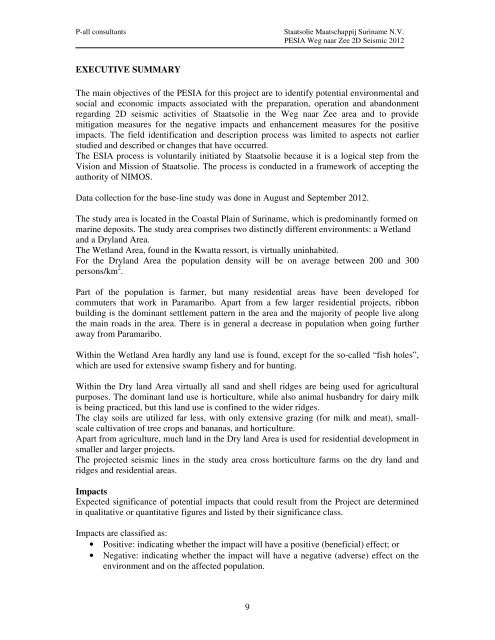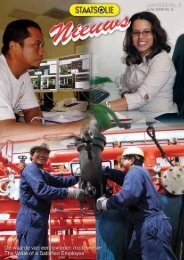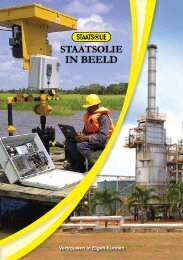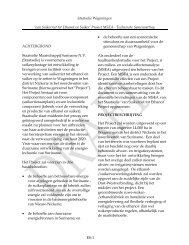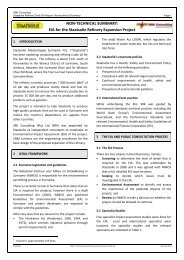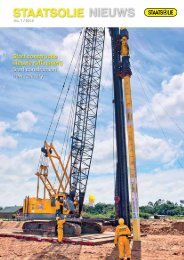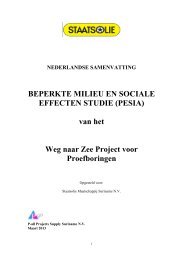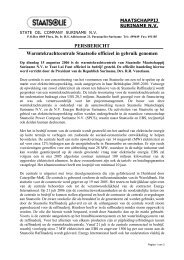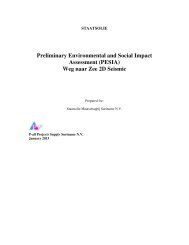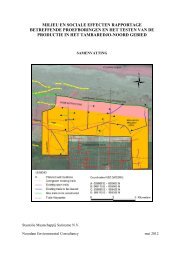(PESIA) Weg naar Zee 2D Seismic - Staatsolie
(PESIA) Weg naar Zee 2D Seismic - Staatsolie
(PESIA) Weg naar Zee 2D Seismic - Staatsolie
You also want an ePaper? Increase the reach of your titles
YUMPU automatically turns print PDFs into web optimized ePapers that Google loves.
P-all consultants <strong>Staatsolie</strong> Maatschappij Suriname N.V.<br />
<strong>PESIA</strong> <strong>Weg</strong> <strong>naar</strong> <strong>Zee</strong> <strong>2D</strong> <strong>Seismic</strong> 2012<br />
EXECUTIVE SUMMARY<br />
The main objectives of the <strong>PESIA</strong> for this project are to identify potential environmental and<br />
social and economic impacts associated with the preparation, operation and abandonment<br />
regarding <strong>2D</strong> seismic activities of <strong>Staatsolie</strong> in the <strong>Weg</strong> <strong>naar</strong> <strong>Zee</strong> area and to provide<br />
mitigation measures for the negative impacts and enhancement measures for the positive<br />
impacts. The field identification and description process was limited to aspects not earlier<br />
studied and described or changes that have occurred.<br />
The ESIA process is voluntarily initiated by <strong>Staatsolie</strong> because it is a logical step from the<br />
Vision and Mission of <strong>Staatsolie</strong>. The process is conducted in a framework of accepting the<br />
authority of NIMOS.<br />
Data collection for the base-line study was done in August and September 2012.<br />
The study area is located in the Coastal Plain of Suriname, which is predominantly formed on<br />
marine deposits. The study area comprises two distinctly different environments: a Wetland<br />
and a Dryland Area.<br />
The Wetland Area, found in the Kwatta ressort, is virtually uninhabited.<br />
For the Dryland Area the population density will be on average between 200 and 300<br />
persons/km 2 .<br />
Part of the population is farmer, but many residential areas have been developed for<br />
commuters that work in Paramaribo. Apart from a few larger residential projects, ribbon<br />
building is the dominant settlement pattern in the area and the majority of people live along<br />
the main roads in the area. There is in general a decrease in population when going further<br />
away from Paramaribo.<br />
Within the Wetland Area hardly any land use is found, except for the so-called “fish holes”,<br />
which are used for extensive swamp fishery and for hunting.<br />
Within the Dry land Area virtually all sand and shell ridges are being used for agricultural<br />
purposes. The dominant land use is horticulture, while also animal husbandry for dairy milk<br />
is being practiced, but this land use is confined to the wider ridges.<br />
The clay soils are utilized far less, with only extensive grazing (for milk and meat), smallscale<br />
cultivation of tree crops and bananas, and horticulture.<br />
Apart from agriculture, much land in the Dry land Area is used for residential development in<br />
smaller and larger projects.<br />
The projected seismic lines in the study area cross horticulture farms on the dry land and<br />
ridges and residential areas.<br />
Impacts<br />
Expected significance of potential impacts that could result from the Project are determined<br />
in qualitative or quantitative figures and listed by their significance class.<br />
Impacts are classified as:<br />
• Positive: indicating whether the impact will have a positive (beneficial) effect; or<br />
• Negative: indicating whether the impact will have a negative (adverse) effect on the<br />
environment and on the affected population.<br />
9


